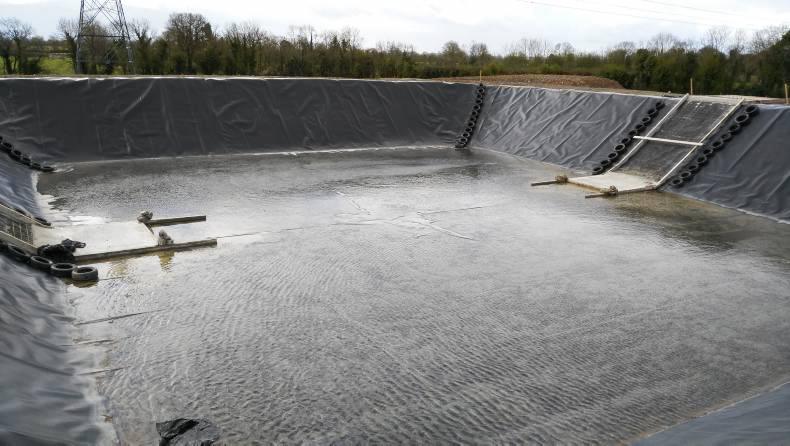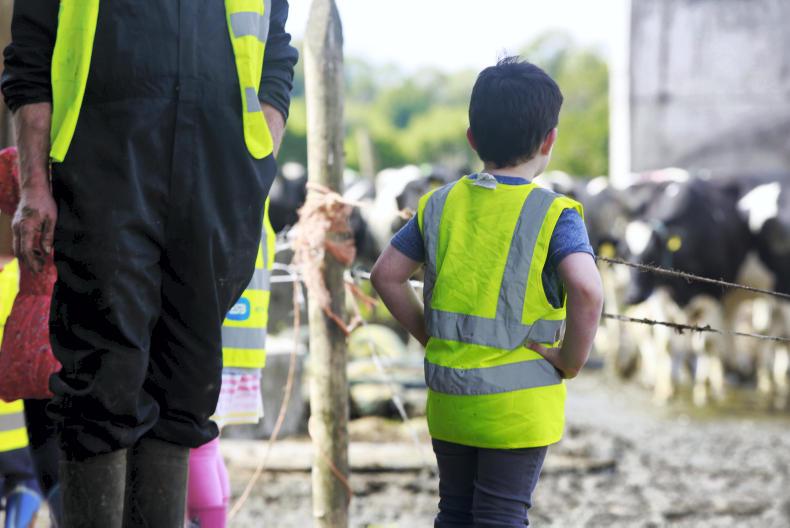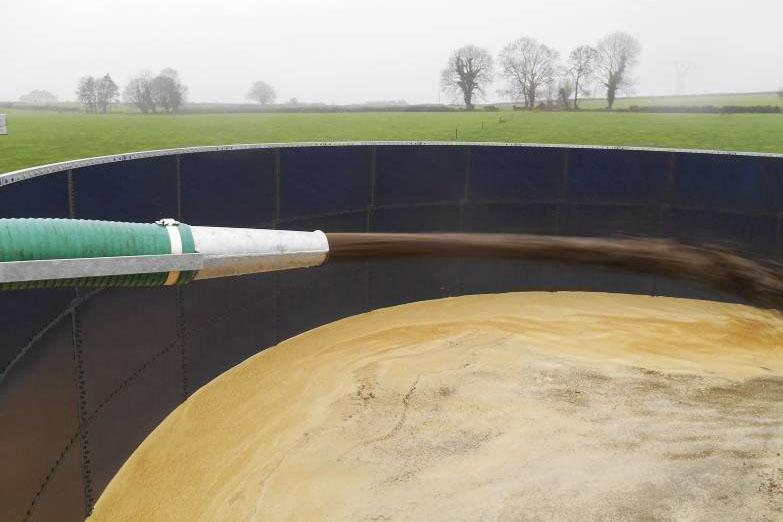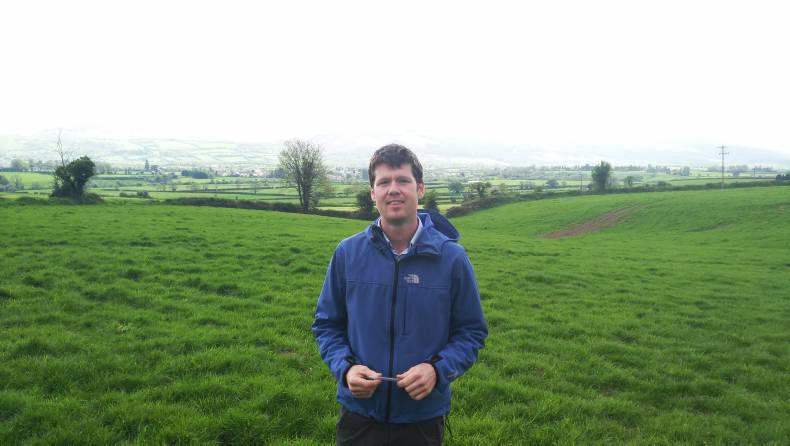In the second instalment of our three-week series on the main slurry storage options covered in TAMS II, we are looking at the option of building a geomembrane-lined slurry store (lagoon).
Last week, we looked at the costs of installing a concrete slurry tank and the possible grant aid a farmer may receive from a successful TAMS II application. Concrete slurry tanks have the advantage of being easily upgraded and slatted for animal housing in the future. However, they are usually the more costly option, especially when large-scale slurry storage is required.
Another option for slurry storage on farms is the geomembrane-lined slurry stores and they are also covered in TAMS II. Lagoons offer a more cost-effective option for farmers who need large-scale slurry storage on their farms in a short time period compared to concrete slurry tanks. However, not every site is suitable for lagoons and some county councils are slow to grant planning permission for their installation.
Advantages of a lagoon
It is one of the more cost-effective options for storing large volumes of slurry.Once planning permission is obtained, installation should be very fast (some contractors claim installation can be achieved in two to three weeks).Disadvantages of a lagoon
Planning permission for lagoons can be difficult to achieve in some county councils.Some sites are not suitable for lagoons (very rocky areas).A safety fence must be erected.Difficult to extend at a later date.Can gather a significant amount of rainwater.Geomembrane-lined slurry store (lagoon) example
Aidan Kelly from Agri Design and Planning Services in Newcastle, Clonmel, Co Tipperary assisted us again this week with plans for two different sizes of lagoons that farmers may install.
Figure 1 shows the plans of a lagoon designed to hold 16 weeks of slurry for a 100-cow herd. The lagoon has capacity for 350,000 gallons of slurry. It is 25.5m long, 25.5m wide and 3.6m deep. There are two concrete based agitation points at either end of the lagoon to support a tractor and lagoon agitator.
Table 1 shows the Department’s reference costs for building this size of lagoon and the maximum grant aid available for a successful TAMS II applicant. This lagoon costs a total of €37,485 excluding VAT to build. Under the Young Farmer Capital Investment Scheme (YFCIS) in TAMS, the maximum grant an applicant could receive if building this size of lagoon is €22,491.09. A non-qualifying YFCIS farmer could apply for grant aid through the Animal, Welfare, Safety and Nutrient Storage Scheme, where the maximum grant would be €14,994.06.
Figure 2 shows the plans of a lagoon designed to hold 16 weeks of slurry for a 200 cow herd. The lagoon has capacity for 700,000 gallons of slurry. It is 35m long, 35m wide and 3.6m deep. As before there are two agitation points at either end of the lagoon. Table 2 shows the Department’s reference costs for building this size of lagoon and the maximum grant aid available for a successful TAMS II applicant. In total, this lagoon, which suits a 200-cow herd, costs €55,346.85 excluding VAT.
Under the YFCIS in TAMS, the maximum grant an applicant could receive if building this size of lagoon is €33,208.11. A non-qualifying YFCIS farmer could apply for grant aid through the Animal, Welfare, Safety and Nutrient Storage Scheme, where the maximum grant would be €22,138.74.
Main specifications
According to the Department, all the specifications are the responsibility of the lining contractor, or in accordance with the lining contractor’s instructions. Farmers planning to install a lined slurry store through TAMS must use a contractor from the approved Department list. The main specifications for geomembrane-lined slurry stores is listed on the Departments website under S126.
Location
The Department says a storage facility must be located not less than 50m from any water body in the case of new farmyards, and not less than 10m in the case of extensions/modifications to an existing facility. The minimum distance between a storage facility and a public or domestic water supply source, either surface or ground, must be 60m. In vulnerable locations, this distance should be increased up to 300m.
Bank stability
On all sites, the topsoil within the slurry/effluent store perimeter and for a minimum distance of 1.5m outside it must be removed. The banks of the store must be a minimum of 600mm high above ground level and be well-compacted. The banks may be constructed of suitable excavated material as assessed by the lining contractor. The banks must be excavated to a slope, which will maintain stability in the prevailing ground conditions and with regard to the soil type. The slope angle should normally be 45o, but in certain soils the angle may be steeper. In no circumstance can the bank slope be steeper than 55o. The banks must be wide enough to allow permanent stability of the bank and for safe access to the chosen agitation point(s).
The excavated and made-up ground must be finished uniform and smooth and free of any sharp protuberances. In particular, the surfaces to be lined must be free of water, jagged rock, debris, roots or any matter that could damage the lining material. A minimum 75mm layer of pea gravel (10mm max particle size) must be used on all slurry store floors. In stony ground a quarry dust layer (5mm to fines), 50mm thick, must be applied on all side slopes.
Before lining commences, the formation must be examined by the lining contractor to ensure suitability. An acceptance certificate will then be issued to record that the ground preparation has been carried out in full accordance with the contractor’s recommendations. The first portion of the contractor’s certificate must be completed at this stage.
Anchoring trench
The anchor trench (which holds the liner in place and prevents it from slipping) must be carefully formed and compacted, and any undisturbed top soil beneath it must be removed. The anchoring trench must be at least 500mm back from the slurry/effluent store edge and it must be excavated at least 300mm wide and 500mm deep. When the liner has been installed in the prepared store, at least 500mm of liner all round should be available for burial in the anchor trench, which must then be backfilled and compacted.
Leak detection system
A leak detection system must be installed underneath the geomembrane lining. This must consist of one of the following:
1) 50mm land drainage pipes, spaced at 2.5m intervals under the layer of pea gravel.
2) Flat geocomposite drainage tubing (for example Colbondrain) laid in a fan-like fashion and brought to one 160mm diameter pipe that exits the lagoon sidewall. These drainage pipes may be laid over or under the pea gravel.
The pipes, in both cases, must be brought to a 1,000-litre inspection chamber so that monitoring of the discharge can be undertaken.
Agitation and emptying points
Agitation point(s) must consist of:
A tractor access point.A concrete footing (reinforced with steel reinforcing mesh) of sufficient size so that at its edges, turbulence will be dissipated to a level which will not endanger the liner, but in all cases at least 2m square; andA concrete apron at least 1m wide and 100mm thick, steel mesh reinforced, extending from the tractor stand, down the slope to the near edge of the agitator footing.Alternatively, the agitation point must consist of a tractor access point; a 10mm HDPE plate footing (welded to the store liner) of sufficient size so that at its edges, turbulence will be dissipated to a level which will not endanger the liner, but in all cases at least 2m square; and a 10mm HDPE plate apron at least 1m wide (welded to the side slope liner), extending from the tractor stand, down the slope to the near edge of the agitation footing.
Suitable arrangements may be provided by way of sump(s) so that the total contents can be more easily removed. Any sump must be constructed in concrete, or alternatively constructed with a 10mm-thick stock sheet of approved leak-proof material. Any joints between the sump and the liner must be tested and be guaranteed as leak-proof by the contractor.
Tractor access
Tractor access for agitating must be through a gated opening in the surrounding fence, at least 1.8m high and normally 3.6m wide. The access route must be concreted from the fence line to store edge. The access point and tractor stand must either be level or must slope moderately away from the pit edge. Close to the pit edge there must be a raised kerb (wheel stop), at least 300mm high and 600mm wide, across the whole access point (A gap, maximum 1m wide, may be positioned in the centre of the wheel stop to facilitate the use of agitation equipment).
The wheel stop must also be cast into the excavated anchor trench, at least 500mm deep. A tubular steel safety barrier, at least 1.2m high, must be provided around the access point.
In the second instalment of our three-week series on the main slurry storage options covered in TAMS II, we are looking at the option of building a geomembrane-lined slurry store (lagoon).
Last week, we looked at the costs of installing a concrete slurry tank and the possible grant aid a farmer may receive from a successful TAMS II application. Concrete slurry tanks have the advantage of being easily upgraded and slatted for animal housing in the future. However, they are usually the more costly option, especially when large-scale slurry storage is required.
Another option for slurry storage on farms is the geomembrane-lined slurry stores and they are also covered in TAMS II. Lagoons offer a more cost-effective option for farmers who need large-scale slurry storage on their farms in a short time period compared to concrete slurry tanks. However, not every site is suitable for lagoons and some county councils are slow to grant planning permission for their installation.
Advantages of a lagoon
It is one of the more cost-effective options for storing large volumes of slurry.Once planning permission is obtained, installation should be very fast (some contractors claim installation can be achieved in two to three weeks).Disadvantages of a lagoon
Planning permission for lagoons can be difficult to achieve in some county councils.Some sites are not suitable for lagoons (very rocky areas).A safety fence must be erected.Difficult to extend at a later date.Can gather a significant amount of rainwater.Geomembrane-lined slurry store (lagoon) example
Aidan Kelly from Agri Design and Planning Services in Newcastle, Clonmel, Co Tipperary assisted us again this week with plans for two different sizes of lagoons that farmers may install.
Figure 1 shows the plans of a lagoon designed to hold 16 weeks of slurry for a 100-cow herd. The lagoon has capacity for 350,000 gallons of slurry. It is 25.5m long, 25.5m wide and 3.6m deep. There are two concrete based agitation points at either end of the lagoon to support a tractor and lagoon agitator.
Table 1 shows the Department’s reference costs for building this size of lagoon and the maximum grant aid available for a successful TAMS II applicant. This lagoon costs a total of €37,485 excluding VAT to build. Under the Young Farmer Capital Investment Scheme (YFCIS) in TAMS, the maximum grant an applicant could receive if building this size of lagoon is €22,491.09. A non-qualifying YFCIS farmer could apply for grant aid through the Animal, Welfare, Safety and Nutrient Storage Scheme, where the maximum grant would be €14,994.06.
Figure 2 shows the plans of a lagoon designed to hold 16 weeks of slurry for a 200 cow herd. The lagoon has capacity for 700,000 gallons of slurry. It is 35m long, 35m wide and 3.6m deep. As before there are two agitation points at either end of the lagoon. Table 2 shows the Department’s reference costs for building this size of lagoon and the maximum grant aid available for a successful TAMS II applicant. In total, this lagoon, which suits a 200-cow herd, costs €55,346.85 excluding VAT.
Under the YFCIS in TAMS, the maximum grant an applicant could receive if building this size of lagoon is €33,208.11. A non-qualifying YFCIS farmer could apply for grant aid through the Animal, Welfare, Safety and Nutrient Storage Scheme, where the maximum grant would be €22,138.74.
Main specifications
According to the Department, all the specifications are the responsibility of the lining contractor, or in accordance with the lining contractor’s instructions. Farmers planning to install a lined slurry store through TAMS must use a contractor from the approved Department list. The main specifications for geomembrane-lined slurry stores is listed on the Departments website under S126.
Location
The Department says a storage facility must be located not less than 50m from any water body in the case of new farmyards, and not less than 10m in the case of extensions/modifications to an existing facility. The minimum distance between a storage facility and a public or domestic water supply source, either surface or ground, must be 60m. In vulnerable locations, this distance should be increased up to 300m.
Bank stability
On all sites, the topsoil within the slurry/effluent store perimeter and for a minimum distance of 1.5m outside it must be removed. The banks of the store must be a minimum of 600mm high above ground level and be well-compacted. The banks may be constructed of suitable excavated material as assessed by the lining contractor. The banks must be excavated to a slope, which will maintain stability in the prevailing ground conditions and with regard to the soil type. The slope angle should normally be 45o, but in certain soils the angle may be steeper. In no circumstance can the bank slope be steeper than 55o. The banks must be wide enough to allow permanent stability of the bank and for safe access to the chosen agitation point(s).
The excavated and made-up ground must be finished uniform and smooth and free of any sharp protuberances. In particular, the surfaces to be lined must be free of water, jagged rock, debris, roots or any matter that could damage the lining material. A minimum 75mm layer of pea gravel (10mm max particle size) must be used on all slurry store floors. In stony ground a quarry dust layer (5mm to fines), 50mm thick, must be applied on all side slopes.
Before lining commences, the formation must be examined by the lining contractor to ensure suitability. An acceptance certificate will then be issued to record that the ground preparation has been carried out in full accordance with the contractor’s recommendations. The first portion of the contractor’s certificate must be completed at this stage.
Anchoring trench
The anchor trench (which holds the liner in place and prevents it from slipping) must be carefully formed and compacted, and any undisturbed top soil beneath it must be removed. The anchoring trench must be at least 500mm back from the slurry/effluent store edge and it must be excavated at least 300mm wide and 500mm deep. When the liner has been installed in the prepared store, at least 500mm of liner all round should be available for burial in the anchor trench, which must then be backfilled and compacted.
Leak detection system
A leak detection system must be installed underneath the geomembrane lining. This must consist of one of the following:
1) 50mm land drainage pipes, spaced at 2.5m intervals under the layer of pea gravel.
2) Flat geocomposite drainage tubing (for example Colbondrain) laid in a fan-like fashion and brought to one 160mm diameter pipe that exits the lagoon sidewall. These drainage pipes may be laid over or under the pea gravel.
The pipes, in both cases, must be brought to a 1,000-litre inspection chamber so that monitoring of the discharge can be undertaken.
Agitation and emptying points
Agitation point(s) must consist of:
A tractor access point.A concrete footing (reinforced with steel reinforcing mesh) of sufficient size so that at its edges, turbulence will be dissipated to a level which will not endanger the liner, but in all cases at least 2m square; andA concrete apron at least 1m wide and 100mm thick, steel mesh reinforced, extending from the tractor stand, down the slope to the near edge of the agitator footing.Alternatively, the agitation point must consist of a tractor access point; a 10mm HDPE plate footing (welded to the store liner) of sufficient size so that at its edges, turbulence will be dissipated to a level which will not endanger the liner, but in all cases at least 2m square; and a 10mm HDPE plate apron at least 1m wide (welded to the side slope liner), extending from the tractor stand, down the slope to the near edge of the agitation footing.
Suitable arrangements may be provided by way of sump(s) so that the total contents can be more easily removed. Any sump must be constructed in concrete, or alternatively constructed with a 10mm-thick stock sheet of approved leak-proof material. Any joints between the sump and the liner must be tested and be guaranteed as leak-proof by the contractor.
Tractor access
Tractor access for agitating must be through a gated opening in the surrounding fence, at least 1.8m high and normally 3.6m wide. The access route must be concreted from the fence line to store edge. The access point and tractor stand must either be level or must slope moderately away from the pit edge. Close to the pit edge there must be a raised kerb (wheel stop), at least 300mm high and 600mm wide, across the whole access point (A gap, maximum 1m wide, may be positioned in the centre of the wheel stop to facilitate the use of agitation equipment).
The wheel stop must also be cast into the excavated anchor trench, at least 500mm deep. A tubular steel safety barrier, at least 1.2m high, must be provided around the access point.









SHARING OPTIONS